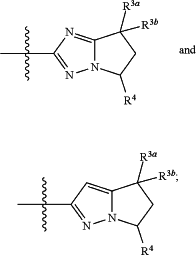| CPC C07D 487/04 (2013.01) [A61P 25/28 (2018.01); C07D 519/00 (2013.01); C07B 2200/05 (2013.01)] | 29 Claims |
|
1. A compound of formula
 or a pharmaceutically acceptable salt thereof, wherein:
RA is selected from the group consisting of:
 s is 0 or 1;
R1 is selected from the group consisting of hydrogen, deutero, fluoro, hydroxyl, cyano, C1-C6 alkyl, C3-C6 cycloalkyl, C1-C6 alkoxy, C1-C6 haloalkyl, C1-C6 haloalkoxy, C1-C6 alkyl substituted with one (RN)2N substituent, C1-C6 cyanoalkyl, C1-C6 alkylsulfonyl, phenyl, benzyl, 4 to 6 membered heterocyclyl, and 5 to 6 membered heteroaryl;
wherein, when R1 is phenyl, benzyl, C1-C6 alkyl, C1-C6 alkoxy or C3-C6 cycloalkyl, the phenyl, C1-C6 alkoxy or cycloalkyl ring is optionally substituted with 1 to 2 substituents selected from the group consisting of fluoro, chloro, cyano, C1-C3 alkyl, cyclopropyl, C1-C3 alkoxy, C1-C3 hydroxyalkyl, C1-C3 haloalkyl, C1-C6 alkoxycarbonyl, C1-C3 alkoxy-C1-C3 alkyl and C1-C3 haloalkoxy;
R2a and R2b are each independently selected from the group consisting of hydrogen, deutero, fluoro, hydroxyl, C1-C3 alkyl, and C1-C3 fluoroalkyl; provided that both R2a and R2b cannot be hydroxyl; or
R1 is selected from the group consisting of hydrogen, deutero, fluoro, methyl, and cyano; and
R2a and R2b together with the carbon atom to which they are both attached form a 4 to 6 membered heterocyclic ring or a 3 to 5 membered carbocyclic ring, each optionally substituted by 1 to 2 substituents selected from the group consisting of fluoro, chloro, hydroxyl, cyano, C1-C3 alkyl, hydroxymethyl, methoxymethyl, C1-C4 alkoxycarbonyl, trifluoromethyl, difluoromethoxy, and trifluoromethoxy;
each RN is independently selected from the group consisting of C1-C6 alkyl, C3-C6 cycloalkyl, C1-C6 alkoxy, and C1-C6 haloalkyl; or two RN together with the nitrogen atom to which they are both attached form a 4-6 membered heterocyclic ring;
each R6 is independently selected from the group consisting of hydrogen, halogen, C1-C6 alkyl, C3-C6 cycloalkyl, C1-C3 cyanoalkyl, C1-C3 alkylcarbonyl, methylsulfonyl, C1-C6 alkoxy, C1-C6 haloalkyl, formyl, C1-C6 haloalkoxy, cyano, 1-methyl-pyrazol-4-yl and pyrimidinyl;
the A ring, the B ring, RB1, RB2, q and p together are selected from the group consisting of:
 one of R3a and R3b is H, and the other is selected from the group consisting of hydrogen, deutero, fluoro, chloro, hydroxyl, cyano, C1-C4 alkyl, C1-C4 haloalkyl, cyclopropyl, C1-C4 alkoxy and C1-C4 haloalkoxy; or
each of Ria and R3b is independently selected from the group consisting of deutero, fluoro, chloro, hydroxyl, cyano, and methyl, provided that Ria and R3b cannot both be OH or CN; or
R3a and R3b, together with the carbon atom to which they are both attached, form 1,1-cyclopropylene; and
R4 is selected from the group consisting of C1-C6 alkyl, C1-C6 haloalkyl, C3-C6 cycloalkyl, C1-C6 alkoxy, C1-C6 haloalkoxy, C1-C6 thioalkyl, phenyl, benzyl, CH2—(C3-C6 cycloalkyl), CH2CH2—(C3-C6 cycloalkyl), CH2-(4 to 6 membered heterocyclyl), CH2CH2-(4 to 6 membered heterocyclyl), 5 to 6 membered heteroaryl, and CH2-(5 to 6 membered heteroaryl); wherein when a phenyl ring is present it may be substituted by 1 to 3 substituents selected from the group consisting of halogen, C1-C4 alkyl, C1-C4 haloalkyl, C1-C4 alkoxy, C1-C4 haloalkoxy, and cyano;
provided that, when RA is
 and R2a and R2b are each hydrogen, R1 is not hydrogen, halogen or methyl.
|